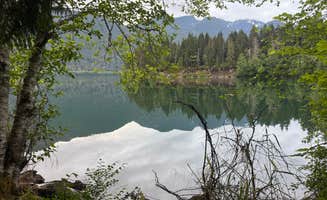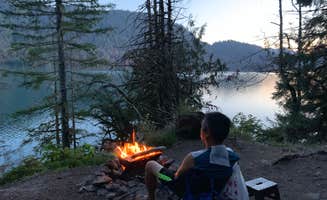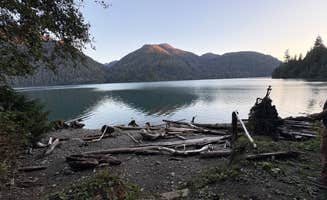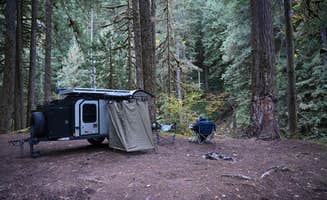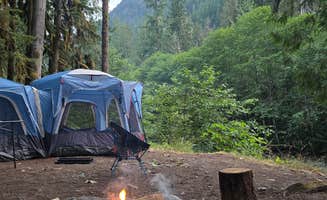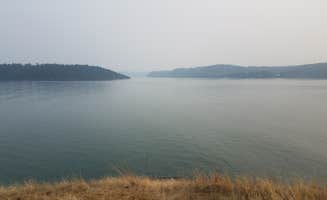Dispersed camping sites near Concrete, Washington lie within the Mount Baker-Snoqualmie National Forest at elevations ranging from 700 to 1,200 feet. The area receives approximately 65 inches of annual rainfall, with driest camping conditions occurring from July through September. Winter access becomes difficult as many forest roads aren't maintained during snow season.
What to do
Water activities at Baker Lake: Kayaking and swimming access points exist along Baker Lake Road Dispersed Campsite, where campers note "plenty of spots with easy lake access" and "spots are close together and there are a lot of people. But we couldn't tell we had people around us."
Hot springs soaking: Free camping areas near Baker Hot Springs provide access to natural thermal pools. Primitive soaking tubs maintain temperatures around 100°F year-round. A camper at nearby Lower Sandy Camp mentioned "our spot (site #3) was tucked away in low area by the water. Semi-private and peaceful."
Forest hiking: Several trail access points exist within 5-10 miles of most dispersed camping areas. The Mountain Loop Hway Dispersed Camp serves as a good base camp for hikers, with one camper noting it offers "meandering sites along the river with good logs for benches and fire rings made from forest rocks."
What campers like
Riverside camping spots: Many free camping areas near Concrete feature river or creek access. At Suiattle Riverside Camp, one camper described their experience as "so beautiful over looking a stream rushing over rocks. Ferns and big pines in the background."
Natural separation between sites: Despite popularity during summer months, many dispersed sites maintain privacy. A reviewer at Baker Lake Road noted "spots are not near each other so you get privacy that way," while another mentioned "if you think all the spots are taken, keep driving. So many spots along Baker Lake Road."
Budget-friendly longer stays: The free camping areas can accommodate extended visits without fees. Campers appreciate this aspect, with one noting at Lower Sandy Camp, "Loved this free campground on Baker Lake near mt baker, WA! Take the first turn after horseshoe cove campground and follow the gravel road all the way to the lake."
What you should know
Road condition challenges: Many forest service roads deteriorate further from highways. A camper at NF Dispersed Camping reported "probably some good camping out this way, but we didn't get more than a mile in our promaster before turning around."
Limited facilities: Most sites lack basic amenities. Lower Sandy Camp stands out with its "pit toilets, fire rings, and picnic tables available. No water," according to one camper. Most other locations require completely self-sufficient camping.
Site cleanliness varies: Trash management remains inconsistent across dispersed sites. A visitor to Mountain Loop Hway noted "easy enough to access right off the mountain loop highway," but others have found issues with previous campers leaving garbage behind.
Tips for camping with families
Site selection timing: Arrive midweek for better family site options. One camper at Lower Sandy mentioned "arrived around 4pm on a Friday and there were a few spots left," suggesting Thursday arrivals provide more choices for family groups needing larger spaces.
Wildlife awareness: Bears and smaller mammals actively search for food throughout summer months. Store all food items in vehicles or bear canisters at night. Campers should maintain clean sites.
Swimming safety: Lake and river access points often feature steep drop-offs without designated swimming areas. At Hard Creek Bridge, a visitor noted the "babbling creek below is a plus," but parents should supervise children near all water features.
Tips from RVers
Length restrictions: Most dispersed sites accommodate smaller RVs under 25 feet. One reviewer at NF 33 Dispersed Camping noted the road "does get much rougher the further you go, so not big-rig friendly nor for low-clearance vehicles."
Leveling requirements: Bring leveling blocks as most sites feature uneven terrain. A camper mentioned spots are "not super level, but worked with limited options available."
Turnaround planning: Scout potential sites before driving deep into forest roads. One RVer recommended "if staying longer I'd say it's best to keep going to south fork sauk," suggesting the extra scouting effort yields better results for vehicle positioning.


